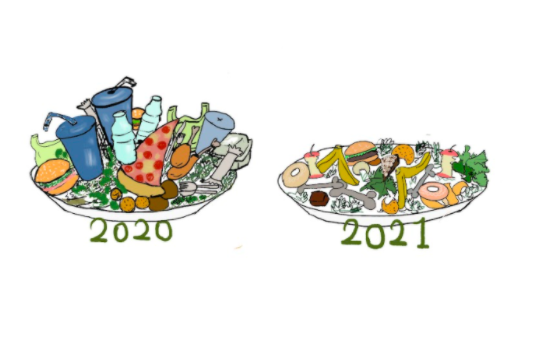After a year of take-out meals and packaged sit-down lunches, Deerfield has returned to its traditional way of dining: self-served walkthrough and waited sit-down meals. Last year, most meals were packaged into compostable take-out boxes and served by Dining Hall staff. This year, however, students have the choice to decide how much food is on their plate. Although last year’s take-out meals may have been convenient and time-friendly, they brought to light the full extent of food wastage at Deerfield.
Under usual dining circumstances, “the Dining Hall forecasts the amount of food that is made every day,” Director of Food Services Michael McCarthy said. The Dining Hall uses a particular database to calculate the ratio of the amount of food made for each meal to the amount of food consumed. Because students often return for seconds or thirds of popular meals such as buffalo chicken sandwiches, the dining hall must make more food to accommodate the need.
Mr. McCarthy explained, “The most important thing really, is to manage how much you make,” and in order to do so, the Dining Hall constantly updates their data to ensure enough food is made to feed everyone and simultaneously keep the food waste to a minimum.

However, last year, due to COVID-19, the Dining Hall was unable to accurately update its data. Because everyone who walked through the Parker Room line was served the same amount of food, the food wastage problem was much more severe compared to this year. Grace Stone ’22 commented, “This year’s [dining method] is much better because the pre-made portions from last year didn’t take into account how each individual has different needs.” Stone also emphasized how “unfinished food was usually thrown out as hall fridges were restricted for a while.”
Food wastage also largely increased last year since the practice of reserving unfinished meals was suspended as a COVID precaution. However, even this year, sit-down meals contribute greatly to food wastage. Angel Zhou ’22 said, “I think sit-down meals generate more food waste than normal walk-through meals, just because of the large serving portions and the table head serving everyone.”
In an effort to make use of excess food from Sunday sit-down meals, every Monday, Deerfield heats up around 100 portions of food to be taken to St. James Church in Greenfield. Koko Akpan ’23 added, “I know that [some of the food] from sit-down meals gets put to the next walkthrough meal which means it’s less waste rather than serving [the food] once and throwing it out.”
Mr. McCarthy shared that, besides controlling how much food is served for the students during take-out meals last year and sit-down meals this year, “the main part of our food waste issue is students taking food that they don’t eat.” He also said, “You’ll see somebody take a bite out of a bagel and throw it out during Snack Time,” and showed an image of the conveyor belt, on which were barely touched plates of food. Mary Lee ’23 added, “When I go to the conveyor belt, I almost always see food that is half-eaten.”
Deerfield not only tries to be more environmentally friendly by decreasing the amount of food waste, but also by decreasing its carbon footprint by sourcing from local sellers as much as possible. Mr. McCarthy shared that “dried goods such as flour and canned tomatoes mostly come from California while produce that is in season such as corn and apples are sourced from local farms.” He added that Deerfield considers any food items acquired from within a 250-mile radius as “locally sourced.”
Deerfield also works with local farms and the Community Development Corporation in order to decrease the harmful impact of food transportation on the environment. This year, Deerfield started buying milk from Maple Line Farm in South Hadley after meeting with the owner over the summer.
The Community Development Corporation is a place where farmers can store unsold produce after a large harvest. They offer space and machinery for rent where farmers can make Individually Quick Frozen (IQF) produce. The produce is blanched while raw and fresh then cooled immediately, which locks in the freshness of the product.
Mr. McCarthy said, “We buy some things out of season from the community Development Corp that we know local farmers use.”
Not only is Deerfield trying to decrease environmental impact, but it’s also trying to alleviate the amount of work for the Dining Hall staff. Mr. McCarthy and the Dining program aim to utilize the school’s resources as efficiently as possible to decrease the amount of food waste.
Acknowledging that there are people who suffer from food insecurity, Mr. McCarthy concluded that “Deerfield should think about what we eat and [we] should recognize how lucky we are to have all the food.”

